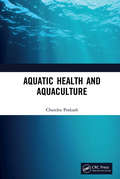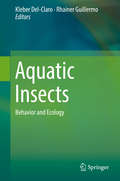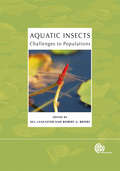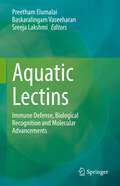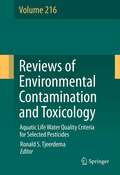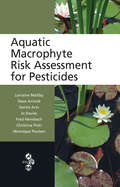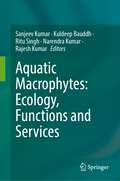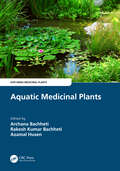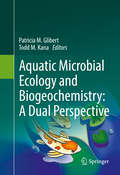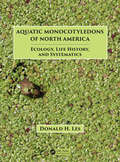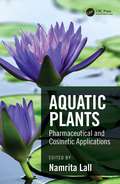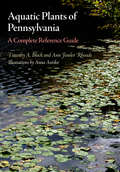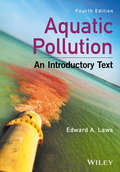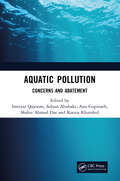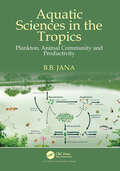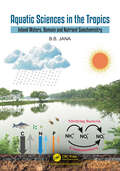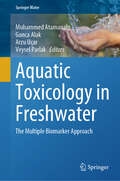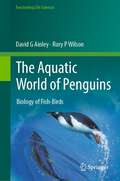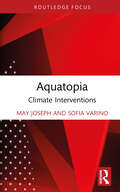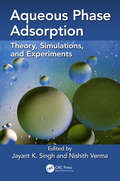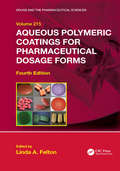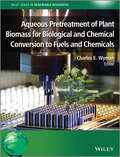- Table View
- List View
Aquatic Health and Aquaculture
by Chandra PrakashThis book discusses how to use the wastewaters, liquid biowastes and soils unfit for agriculture to economically viable aquaculture practices; and putting the emphasis on, aquaculture posology, the science of quantification and administration of doses in aquatic health and aquaculture management. Broadly, aquaculture practices come across three types of problems each; in the context of water quality, and fin fish and shell fish diseases; and preventive, curative and noncurative diseases in fin fish and shell fish. Note: T&F does not sell or distribute the Hardback in India, Pakistan, Nepal, Bhutan, Bangladesh and Sri Lanka.
Aquatic Insects: Behavior and Ecology
by Kleber Del-Claro Rhainer GuillermoThis book presents a broad view of the ecology and behavior of aquatic insects, raising awareness of this conspicuous and yet little known fauna that inhabits inland waterbodies such as rivers, lakes and streams, and is particularly abundant and diverse in tropical ecosystems. The chapters address topics such as distribution, dispersal, territoriality, mating behavior, parental care and the role of sensory systems in the response to external and internal cues. In the context of ecology, it discusses aquatic insects as bio indicators that may be used to assess environmental disturbances, either in protected or urban areas, and provides insights into how genetic connectivity can support the development of novel conservation strategies. It also explores how aquatic insects can inspire solutions for various problems faced by modern society, presenting examples in the fields of material science, optics, sensorics and robotics.
Aquatic Insects: Proceedings of the Royal Entomological Society’s 24th Symposium
by Jill Lancaster Robert A. BriersThis edited volume brings together acknowledged experts in often disparate fields ranging from physiology through ecology to evolution to consider in a unified manner the challenges facing insect populations in aquatic environments and how they have adapted to achieve such prominence in virtually all habitats.
Aquatic Lectins: Immune Defense, Biological Recognition and Molecular Advancements
by Preetham Elumalai Baskaralingam Vaseeharan Sreeja LakshmiThis book provides the latest information on fish lectins from the perspective of inflammation and presents new ideas on the complicated mechanisms of lectin biochemistry and associated interactions. Key features include discussion of mechanisms recently identified to be involving lectin family types, presentation of the latest evidence regarding the molecular approaches in fish lectins, and thorough explanation of the concept of antimicrobial and immunological roles and current understanding of the significance of its disease resistance related studies. Gene expression studies is another important element of the book, and it is proposed that gene editing technology provides gaining attention in the biological role of fish lectin research. Examples of the many lastest molecular approaches, applications and future perspectives in fish lectin specific topics covered in this book include the information right from the basics to the advancements in this area. The book will be a valuable update and resource for both experienced and younger researchers working in the field of lectins and immunology.
Aquatic Life Water Quality Criteria for Selected Pesticides (Reviews of Environmental Contamination and Toxicology #216)
by Ronald S. TjeerdemaReviews of Environmental Contamination and Toxicology attempts to provide concise, critical reviews of timely advances, philosophy and significant areas of accomplished or needed endeavor in the total field of xenobiotics, in any segment of the environment, as well as toxicological implications.
Aquatic Macrophyte Risk Assessment for Pesticides
by Lorraine Maltby Dave Arnold Gertie Arts Jo Davies Fred Heimbach Christina Pickl Veronique PoulsenGiven the essential role that primary producers play in aquatic ecosystems, it is imperative that the potential risk of pesticides to the structure and functioning of aquatic plants is adequately assessed. An integration of regulatory and research information from key specialists in the area of environmental regulation, Aquatic Macrophyte Risk Asse
Aquatic Macrophytes: Ecology, Functions and Services
by Sanjeev Kumar Kuldeep Bauddh Ritu Singh Narendra Kumar Rajesh KumarThis book is a comprehensive collection of information about the features, functions, and services of aquatic macrophytes. As primary producers, aquatic macrophytes form the basis of food webs, play a major role in highly productive aquatic ecosystems, and have a significant impact on ecosystem functions and services. Macrophytes are also known to strongly influence the micro-climate and biogeochemical processes occurring in the littoral zones of marine ecosystems and the sediment dynamics of freshwater systems. They also serve as highly effective carbon sinks and play an important role in carbon sequestration. This book deals with various aspects of aquatic macrophytes, including nutrient recycling, biogeochemical processes, biomass production, wetland ecosystems, water resource management, carbon sequestration, environmental clean-up, and bioenergy production. Additionally, it presents the current status of aquatic macrophytes and discusses the impact of climate change on these plants. The book also highlights the major challenges associated with harnessing the benefits provided by aquatic macrophytes as ecosystem services. The book holds value and relevance for academicians and scientists working in the related domain. Additionally, it will serve as a valuable resource for students and researchers working in the field of ecology, biogeochemistry, wetland conservation, phytoremediation, elements biomonitoring, wastewater management, bioenergy production, etc.
Aquatic Medicinal Plants (Exploring Medicinal Plants)
by Archana Bachheti Rakesh Kumar Bachheti Azamal HusenThe use of medicinal plants in herbal and modern medicine has gained popularity over the last few decades due to consumers taking more natural approaches to medicine. Aquatic medicinal plants are rich in bioactive compounds and demonstrate various commercial, nutraceutical, and biological applications. Aquatic Medicinal Plants offers the reader a wealth of information on uses of bioactive components of these plants, along with crucial references, and explains their traditional uses, phytochemistry, and pharmacological properties.Features Provides information on aquatic and semiaquatic medicinal plants and their uses globally. Discusses phytochemical components with the known active constituents and their pharmaceutical applications. This volume in the Exploring Medicinal Plants series is appropriate for scientists, experts, and consultants associated with the exploration of aquatic medicinal plant usage. This book is an essential tool for identifying important aquatic medicinal plants and possibilities for the synthesis or preparation of modern drugs.
Aquatic Mesocosm Studies in Ecological Risk Assessment
by Robert L. GraneyA Special Publication of the Society of Environmental Toxicology and Chemistry (SETAC)Aquatic Mesocosm Studies in Ecological Risk Assessment discusses the methods currently used for conducting simulated field studies and provides a series of case histories in which mesocosm type studies have been used to assess the impact of pesticides on aquatic ecosystems. Specific chapters address the dosing and exposure components of such studies and how they influence experimental design. Advantages and disadvantages of various statistical designs are addressed in detail. Regulatory aspects of the design and interpretation of these studies are also covered. The book will be a superb reference for aquatic biologists, ecologists, toxicologists, environmental toxicologists, environmental chemists, and regulatory personnel.
Aquatic Microbial Ecology and Biogeochemistry: A Dual Perspective
by Patricia M. Glibert Todd M. KanaThis book highlights perspectives, insights, and data in the coupled fields of aquatic microbial ecology and biogeochemistry when viewed through the lens of collaborative duos - dual career couples. Their synergy and collaborative interactions have contributed substantially to our contemporary understanding of pattern, process and dynamics. This is thus a book by dual career couples about dual scientific processes. The papers herein represent wide-ranging topics, from the processes that structure microbial diversity to nitrogen and photosynthesis metabolism, to dynamics of changing ecosystems and processes and dynamics in individual ecosystems. In all, these papers take us from the Arctic to Africa, from the Arabian Sea to Australia, from small lakes in Maine and Yellowstone hot vents to the Sargasso Sea, and in the process provide analyses that make us think about the structure and function of all of these systems in the aquatic realm. This book is useful not only for the depth and breadth of knowledge conveyed in its chapters, but serves to guide dual career couples faced with the great challenges only they face. Great teams do make great science.
Aquatic Monocotyledons of North America: Ecology, Life History, and Systematics
by Donald H. LesThis book brings together information on the natural history, ecology and systematics of North American aquatic monocotyledons. The book is an overview of the biology of major aquatic species by compiling information from numerous sources that lie scattered among the primary literature, herbarium databases, and other reference sources. Information on more than 300 species in 87 genera of monocotyledons will be included. Recent phylogenetic analyses will be incorporated. Although focusing specifically on North America, the cosmopolitan distribution of many aquatic plants should make this an attractive text to people working virtually anywhere outside of the region as well. Key Selling Features: The primary source of natural history information on aquatic plants Comprehensive lists of ecological associates Synthetic overview of systematic relationships of aquatic species and genera Practical information for rare and invasive plant managers Essential guide to facilitate wetland delineation
Aquatic Organic Matter Fluorescence
by Paula G. Coble Jamie Lead Andy Baker Darren M. Reynolds Robert G. M. Spencer Paula G. Coble Jamie Lead Andy Baker Darren M. ReynoldsThis is the first comprehensive text on the theory and practice of aquatic organic matter fluorescence analysis, written by the experts who pioneered the research area. This book covers the topic in the broadest possible terms, providing a common reference for making measurements that are comparable across disciplines, and allowing consistent interpretation of data and results. The book includes the fundamental physics and chemistry of organic matter fluorescence, as well as the effects of environmental factors. All aspects of sample handling, data processing, and the operation of both field and laboratory instrumentation are included, providing the practical advice required for successful fluorescence analyses. Advanced methods for data interpretation and modeling, including parallel factor analysis, are also discussed. The book will interest those establishing field, laboratory, or industrial applications of fluorescence, including advanced students and researchers in environmental chemistry, marine science, environmental geosciences, environmental engineering, soil science, and physical geography.
Aquatic Physiosphere-Biosphere Dynamics and Modelling: A Reference for Studies of the Coupled System
by Aike BeckmannThis encyclopedia is a reference for aquatic physical, biological and biogeochemical sciences, collecting and connecting a number of topics, concepts and facts about aquatic systems and their scientific investigation. The scope of the book comprises the aquatic physiosphere-biosphere transition zone, an entity that encompasses both inanimate matter and collectives (the physiosphere) as well as living organisms and collectives (the biosphere). This combined approach is meaningful because both realms are intimately linked and because available methods of investigation are often similar. Much can be gained from considering both spheres at and across their interface jointly, and while there is a strong focus on marine systems, most concepts presented are also applicable to freshwater systems. This presented snapshot of knowledge of the transition zone between the aquatic physiosphere and biosphere is taken from a very specific angle: the point of view of a modeler. Modeling is not only a state-of-the-art mode of scientific investigation, but also requires the explicit specification of all assumptions (helping to avoid fallacies), and offers the advantage of being quantitative and allows for theoretical "what if" scenarios.As in any reference work, equal emphasis is given to fundamental facts, the definition of terms and the explanation of concepts, in an attempt to establish a joint language for physicists, biologists and biogeochemists. Although originating from a modeler's approach to nature, the resulting suite of compatible concepts may also be useful beyond modeling purposes. Furthermore, the material is presented in a condensed, straightforward way. Hence, the length of each entry is limited to one (occasionally two) pages, thus offering a quick introductory overview. This excludes lengthy derivations and very specialized details. The book is geared towards researchers, teachers and advanced students in the field of aquatic (marine and limnic) sciences, in particular those interested or involved in interdisciplinary work.
Aquatic Plants: Pharmaceutical and Cosmetic Applications
by Namrita LallAquatic Plants: Pharmaceutical and Cosmetic Applications provides a concise description of popular aquatic plants found across the globe. The chapters in this beautifully illustrated, full-color book focus on the aquatic species native to specific continents. Written by a global team of experts, this book explains the distribution, ethnobotanical uses, genome sequencing, chemical compounds, and biological activity of these plants and addresses the cultivation and sustainable production of aquatic and wetland plants. Features: Describes the biological activity of a large collection of aquatic plants. Color photographs highlight each plant’s ethnobotanical characteristics, and structural formulae show their chemical constituents. Contributions come from leading scientists from countries including the United States, India, Mauritius, South Africa, and Cyprus. Aquatic Plants: Pharmaceutical and Cosmetic Applications is a valuable resource for academics conducting research on aquatic plants and for professionals in the pharmaceutical and cosmetic industries who are involved with the therapeutic applications of these plants and their sustainable usage.
Aquatic Plants of Pennsylvania: A Complete Reference Guide
by Timothy A. Block Ann Fowler RhoadsFrom the Delaware River to the shores of Lake Erie, Pennsylvania's diverse watery habitats are home to more than 200 species of aquatic plants. In Aquatic Plants of Pennsylvania: A Complete Reference Guide, botanists Timothy A. Block and Ann Fowler Rhoads have assembled the first identification guide specific to the Keystone State yet useful throughout the Mid Atlantic region. Organized and written in a way that will make information easily accessible to specialists and nonspecialists alike, the book highlights the diversity and vital ecological importance of this group of plants, providing photographs, illustrations, descriptions, and identification keys for all emergent, floating-leaved, and submergent aquatic plants found in the Commonwealth.An introductory chapter on aquatic plant ecology covers topics such as evolution, form, and reproduction of aquatic plants, vegetation zones, types of aquatic ecosystems, and rare and endangered species. Information on invasive plants, such as Eurasian water-milfoil and curly pondweed, that threaten Pennsylvania's aquatic ecosystems will be especially useful to watershed organizations, citizen monitoring projects, lake managers, and natural resource agency personnel. An illustrated identification key guides the reader through a series of steps to properly identify a specimen based on its characteristics. Each of the more than 200 listings provides a plant's taxonomy, detailed description, distribution map, and expert botanical illustrations. Many also include color photographs of the plants in their natural habitats.
Aquatic Pollution: An Introductory Text
by Edward A. LawsSince the publication of the third edition of Aquatic Pollution in 2000, there have been many major developments within the field in terms of research, regulations, and also large-scale catastrophes that have had a significant impact on the aquatic environment; the Deepwater Horizon oil spill and the Fukushima nuclear disaster have taken their toll, and research on ocean acidification has developed enormously over the last decade. Recognizing, controlling, and mitigating aquatic pollution on a global scale is one of the most important and most difficult challenges facing society today.Fully updated to reflect current understanding and discussing these major recent developments, this fourth edition of Aquatic Pollution covers every aspect of pollution associated with urban runoff, acid rain, sewage disposal, pesticides, oil spills, nutrient loading, and more. Case studies of major pollution sites, all original to this new edition, help to illustrate points made in general discussion.Offering unprecedented depth of coverage, and discussing both fresh and sea water environments, this unique text provides a key teaching and learning tool for courses in environmental science, zoology, oceanography, biology, and civil or sanitary engineering, as well as a vital book for government policy makers. It is also an excellent primer for policymakers and activists focused on environmental issues.
Aquatic Pollution: Concerns and Abatement
by Imtiyaz Qayoom Adnan Abubakr Anu Gopinath Shabir A. Dar Keezia KhurshidThis book discusses the sources, mechanism, impact and abatement of pollution in waterbodies and lays a base foundation for further research. In this book, readers will also get acquainted with the methods of decontamination of lakes by phytoremediation, pesticide removal techniques from lakes, toxic site reclamation and environmental sustainability using microbial aspects associated with clean-up of wastes.Based on the issues related to pollution of aquatic environments, the subject matter of this book includes: Nanoplastic Pollutants Affecting Fisheries Sector All Over the World Freshwater Floral Diversities as Pollution Indicators Radioactive Waste: Sources and Impact on Environment Environmental Sustainability Using Microbial Aspects Associated With Clearing Up Waste Nitrates and Phosphates: Boon or Bane for Waterbodies Print edition not for sale in South Asia (India, Sri Lanka, Nepal, Bangladesh, Pakistan and Bhutan)
Aquatic Sciences in the Tropics: Plankton, Animal Community and Productivity
by B. B. JanaThe anatomy of water, water as a substance, water as a medium, the principles of the hydrologic cycle, the economics of water, and challenges are all covered in the first chapter of this book. The horizon of the tropical world, the environment, particularly the tropical environment, aquatic biome, tropical aquatic bionetwork, concept of biosphere, and tropical limnology are all covered in the second chapter. The third chapter covers the following topics: the origins of lakes, general lake classification, tropical lakes, lake morphometry, morpho-edaphic index, trophic status index of lakes, wetlands, and mangroves in tropical regions. The lotic environment is the main topic of the fourth chapter, which also covers the idea of stream order, the differences between rivers and streams, the river continuum, physical, chemical, and biological characteristics, and adaptations of fish found in hill streams. Chapter five covers the prokaryota, cyanobacteria, freshwater biota, and water-adapted organisms. The sixth chapter focuses on the algal communities Xanthophyceae, Euglenophyceae, Bacillariophyceae, Chrysophyceae, Phaeophyceae (brown algae), and Chlorophyceae. The seventh and last chapter covers the following topics: Protozoa, Porifera, Rotifera, Coelenterata, Annelida, Arthropoda, Crustacea, Aquatic Insects, Mollusca, Echinodermata, and Brachiopodaa.
Aquatic Sciences in the Tropics: Inland Waters, Domain and Nutrient Geochemistry
by B.B. JanaThe tropical environment is unique due to its geographic location, climatic features, intense solar radiation, high temperature, heavy precipitation, less seasonal variation, enhanced food and productivity, faster metabolism, ecological dynamics and co-evolutionary processes that favor niches for specialized species. It also provides the richest biodiversity with endemic fish species that support millions of people in rural areas. This book Aquatic Sciences in the Tropics: Inland Waters, Domain and Nutrient Geochemistry comprises nine primary chapters that address various topics. Chapter 1 covers topics such as Water as a Substance, Water as a Medium, Fundamentals of Global Water Distribution and Hydrologic Cycle, Economics of Water and Challenges; Chapter 2: The Environment, Tropical Environment, Concept of Biosphere and Aquatic Biome, Tropical Aquatic Bionetwork, Tropical Limnology; Chapter 3: Origin of Lakes, General Classification of Lakes, Tropical Lakes, Lake Morphometry, Morpho-Edaphic Index, Trophic State Index of Lakes, Wetlands, Mangroves; Chapter 4: Concept of Stream Order, Streams and Rivers, The River Continuum Concept, Physico-chemical and Biological Features of Streams, Adaptations of Hill Stream Fishes; Chapter 5: Light as an Entity, Thermal Regime, Thermal Stratification, Lake Mixing, Turnover and Circulation; Chapter 6: Sources of CO2 in Inland Waters, Hydrogen Ion Concentration, The CO2–CO3–HCO3 System, Alkalinity, Hardness; Chapter 7: Dissolved Oxygen, Oxidation and Reduction Potential; Chapter 8: Total Dissolved Solids, Dissolved Organic Carbon; Chapter 9: Origin of Atmospheric Gases, Carbon and Carbon Cycle, Nitrogen, Nitrogen Fixation, Ammonification, Nitrification and Comammox, Denitrification and Anammox, Phosphorus and Sulphur.It is anticipated that the academic community, students, teachers, instructors, researchers, colleges, universities, institutions, administrators, policy makers, public libraries and the general public with an interest in these topics will find this text to be a valuable source of information and provide in-depth knowledge.
Aquatic Toxicology in Freshwater: The Multiple Biomarker Approach (Springer Water)
by Muhammed Atamanalp Gonca Alak Arzu Uçar Veysel ParlakThis book will provide an important source of practical information on the history of toxicology, the ways in which pollutants reach model organisms used in toxicology, sampling methods for research, mechanisms of toxicity and responses of aquatic organisms to toxic agents, as well as the use of therapeutic agents in current approaches. Determining the importance of environmentally friendly substances on antioxidant defense is an obvious area of future research.The combined use of a biomarkers range that can indicate exposure to pollutants and measure their effects on living organisms enables a more comprehensive and integrative assessment of indicator organisms in the aquatic environment, both biochemically and cellularly. In conclusion, the multiple biomarker approach had received great interest in ecotoxicological research and had recently been adapted to both field and laboratory studies.
The Aquatic World of Penguins: Biology of Fish-Birds (Fascinating Life Sciences)
by David G Ainley Rory P WilsonCenturies ago, when penguins were first encountered by European explorers, they were not thought to be birds but rather a fish-like relative. Subsequent accumulation of knowledge has shown penguins to be an avian species with unrivaled aquatic attributes, owing to a number of evolutionary adaptations: shape change, low drag, ability to regulate buoyancy, and extraordinary surface compliancy from their featheration. They are indeed the most extremely specialized diving bird, having given up flight (which otherwise is hugely advantageous) to the benefit of underwater prowess (such as speed, maneuverability and an ability to exploit an extraordinary range of depths). This flightlessness, however, also comes with costs that are substantial for a seabird (such as the inability to cover large distances quickly in reaction to ephemeral prey); and the energy needed to cope with moving through an aqueous environment, which is more resistant than air. For penguins, the high energetic costs in exploiting the ocean environment thus makes them especially sensitive to changes in food availability or their access to their prey. While a number of “penguin books” cover the natural history, mainly of breeding aspects, few address in much detail the incredible aquatic nature of these creatures. A huge amount of information has been amassed over recent past decades thanks to dramatic advances in microelectronics, bio-logging and maturation of some long-term studies of penguin life history. This work represents an integration of all these data with charts, maps and graphs, along with richly illustrated photos by experts in the field.
Aquatopia: Climate Interventions (Critical Climate Studies)
by May Joseph Sofia VarinoAquatopia documents Harmattan Theater’s ecological interventions and traces its engagements with water-bound landscapes, colonial histories, climate change, and public space across New York City, Venice, Amsterdam, Lisbon, and Cochin. The volume uses Harmattan’s site-specific performances as a point of departure to consider climate change and rising sea levels as geographical, ecological, and urban phenomena. Instead of a collection of flat, static surfaces, the Aquatopia atlas is animated by a disorienting, anti-mapping strategy, producing a deterritorialized, nomadic, fluid atlas unfolding in real time as an archive of climate change in multidimensional, active space. The book is designed for pedagogical access, with interludes that consolidate the learning outcomes of the experimental theory animating each site-specific performance. Accompanied by close descriptions of five performances and supplemented by digital documentation available online, this volume intervenes in discussions on climate change, urbanism, and postcolonization/decolonialization, and contributes to interdisciplinary studies of ecology and environmental politics, postcolonial/decolonial theories and practices, performance studies and aesthetics, in particular public art, and performance as research.
Aqueous Phase Adsorption: Theory, Simulations and Experiments
by Jayant Singh Nishith VermaThis book covers theoretical aspects of adsorption, followed by an introduction to molecular simulations and other numerical techniques that have become extremely useful as an engineering tool in recent times to understand the interplay of different mechanistic steps of adsorption. Further, the book provides brief experimental methodologies to use, test, and evaluate different types of adsorbents for water pollutants. Through different chapters contributed by accomplished researchers working in the broad area of adsorption, this book provides the necessary fundamental background required for an academician, industrial scientist or engineer to initiate studies in this area. Key Features Explores fundamentals of adsorption-based separation Provides physical insight into aqueous phase adsorption Includes theory, molecular and mesoscopic level simulation techniques and experiments Describes molecular simulations and lattice-Boltzmann method based models for aqueous phase adsorption Presents state-of-art experimental works particularly addressing removal of "emerging pollutants" from aqueous phase
Aqueous Polymeric Coatings for Pharmaceutical Dosage Forms (Drugs and the Pharmaceutical Sciences)
by Linda A. FeltonAqueous-based film coating has become routine in the pharmaceutical industry. This process eliminates the use of organic solvents and thus avoids economic, environmental, and toxicological issues related to residual solvents and solvent recovery. Aqueous-based coating, however, is complex and many variables may impact the final product and its performance. This fourth edition of Aqueous Polymeric Coatings for Pharmaceutical Dosage Forms aims to provide insight into the factors and parameters that should be considered and controlled for the successful development and commercialization of a coated product. The fourth edition has been revised and expanded to reflect the most recent scientific advancements from the literature. The contributing authors explain in detail, using illustrated examples, appropriate steps to solve and ideally avoid formulation, processing, and stability problems and to achieve an optimized dosage form. Trade names and chemical names of commercially marketed coatings are used throughout the text to help familiarize the reader with the various materials available for pharmaceutical applications. This book will be a valuable resource for anyone in the pharmaceutical industry working in the area of aqueous-based film coating.
Aqueous Pretreatment of Plant Biomass for Biological and Chemical Conversion to Fuels and Chemicals
by Charles E. WymanPlant biomass is attracting increasing attention as a sustainable resource for large-scale production of renewable fuels and chemicals. However, in order to successfully compete with petroleum, it is vital that biomass conversion processes are designed to minimize costs and maximize yields. Advances in pretreatment technology are critical in order to develop high-yielding, cost-competitive routes to renewable fuels and chemicals.Aqueous Pretreatment of Plant Biomass for Biological and Chemical Conversion to Fuels and Chemicals presents a comprehensive overview of the currently available aqueous pretreatment technologies for cellulosic biomass, highlighting the fundamental chemistry and biology of each method, key attributes and limitations, and opportunities for future advances.Topics covered include:* The importance of biomass conversion to fuels* The role of pretreatment in biological and chemical conversion of biomass* Composition and structure of biomass, and recalcitrance to conversion* Fundamentals of biomass pretreatment at low, neutral and high pH* Ionic liquid and organosolv pretreatments to fractionate biomass* Comparative data for application of leading pretreatments and effect of enzyme formulations* Physical and chemical features of pretreated biomass* Economics of pretreatment for biological processing* Methods of analysis and enzymatic conversion of biomass streams* Experimental pretreatment systems from multiwell plates to pilot plant operations This comprehensive reference book provides an authoritative source of information on the pretreatment of cellulosic biomass to aid those experienced in the field to access the most current information on the topic. It will also be invaluable to those entering the growing field of biomass conversion.
